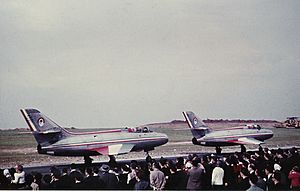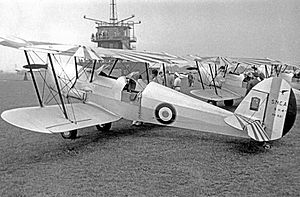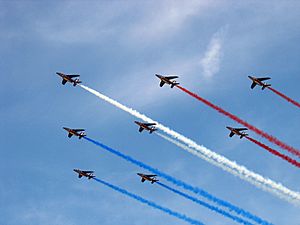Patrouille de France facts for kids
Quick facts for kids Patrouille de France |
|
|---|---|
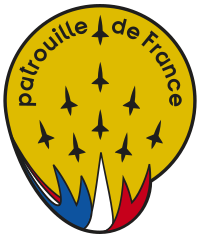
Patrouille de France
|
|
| Active | Active since 1931: Patrouille d'Étampes Patrouille de l'École de l'Air Patrouille de France (official demonstration) 14 September 1931 – Present |
| Country | |
| Branch | French Air and Space Force |
| Role | Aerobatic flight display team |
| Size | 10 Alpha Jet out of which 8 in flight (total size 41) |
| Base | Base Aérienne 701 Salon-de-Provence, Bouches-du-Rhône, France |
| Nickname(s) | La PAF |
| Colors | Blue, white and red |
| Equipment | Alpha Jet |
| Commanders | |
| Notable commanders |
1st Commandant of the Patrouille in 1953 Général de corps aérien Pierre Delachenal |
| Aircraft flown | |
| Trainer | 1953–1954 Republic F-84 1954–1957 Dassault Ouragan 1957–1964 Dassault Mystère IV 1964–1981 Fouga Magister 1981–present Dassault/Dornier Alpha Jet |
The Patrouille de France (pronounced "Pat-rool duh Frahns"), often called the PAF, is a famous team of pilots from the French Air and Space Force. They perform amazing aerobatic displays, flying their planes very close together in cool formations. They officially started in 1953.
This team represents the French Air and Space Force and acts as ambassadors for French aviation around the world. They are based at Salon-de-Provence Air Base in France. The Patrouille de France is one of the oldest aerobatic teams, active since 1931, and is considered one of the best globally.
The team has 9 pilots and 35 mechanics. They spend their winter training hard and their summer performing aerial shows. The Patrouille de France traditionally starts the Bastille Day military parade in Paris. They fly 9 Alpha Jets and perform a twenty-minute show. This show includes changing formations and exciting crossovers.
Contents
History
How the Patrouille de France Started
The first aerial display by a patrol happened in 1931 at Étampes-Mondésir Airport. Instructors from a piloting school performed it using Morane-Saulnier MS.230 planes. The team had three aircraft. Between 1932 and 1939, this team, called the Patrouille d'Étampes, became very successful. They were chosen to represent France at international events.
In 1935, the Patrouille d'Étampes started using MS.225 planes. By 1936, they could fly in formations of five aircraft. In 1937, the team moved to Salon-de-Provence and was renamed Patrouille de l'École de l'Air. Their activities were paused during the Second World War.
The Official Birth of the Patrouille de France
In 1947, the French Air Minister created a special display squadron for the French Air Force. This unit was led by Captain Pierre, who used to fly with the Patrouille d'Étampes. They flew twelve Stampe SV-4 planes. Because these shows were so popular, other display teams were formed within the French Air and Space Force.
In 1952, Commander Pierre Delachenal formed a team of four Republic F-84G planes. During an air show in Algeria on May 17, 1952, a journalist named Jacques Nœtinger was so impressed that he officially named the team "Patrouille de France." The Chief of Staff of the French Air Force confirmed this name on September 14, 1953.
Recent Events and Changes
For the next ten years, different squadrons of the French Air Force took turns continuing the Patrouille de France's traditions. They helped the team become famous worldwide. However, in 1964, due to budget cuts, the team flying Dassault Mystère IV planes was disbanded. To keep the Patrouille de France name alive, the Minister of the Armies decided to adopt the Patrouille de l'École de l'Air a few months later.
The six Fouga Magister planes from Salon-de-Provence Air Base then became the main French aerobatic team for sixteen years. Their last show with nine Fouga Magister planes was on September 16, 1980. In 1981, the Dassault/Dornier Alpha Jet became the new plane for the Patrouille de France, starting with 7 aircraft. This number increased to 8 in 1982.
A memorable display happened in 1986 over New York City. On November 25, 2009, for the first time ever, a woman, Commandant Virginie Guyot, became the leader of an aerobatic team. During the 2020 Summer Olympics closing ceremony in 2021, the Patrouille de France flew over Paris and the Eiffel Tower. This was part of the handover to Paris for the 2024 Games. The Patrouille also performed for their 70th anniversary at the Kleine Brogel Air Base in Belgium in 2023.
Pilots
Every year, three new pilots join the Patrouille. These new pilots are chosen from experienced fighter pilots in the French Air Force who volunteer. They must be qualified to lead a patrol and have flown at least 1500 hours in jet aircraft to apply. The current pilots choose the next three pilots for the team.
In 2009–2010, Commandant Virginie Guyot became the first female pilot to join the Patrouille.
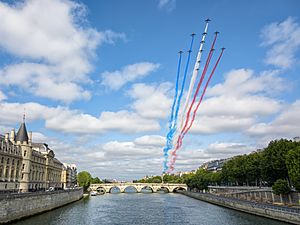
The pilots use "Athos" as their radio call sign:
- The Leader
- Athos 1 is the leader for one year. They are the most important pilot and cannot be replaced. The leader decides with the team what formations and figures they will perform.
- The Interiors
- Athos 2 and Athos 3 are in their first year. They fly next to the leader during flight formations.
- The Scavenger
- Athos 4 flies behind the leader. They will usually take the leader's place the following year.
- The Solos
- Athos 5 (solo leader) and Athos 6 (second solo) perform exciting crossovers and close passes during the second part of the show.
- The Exteriors
- Athos 7 and Athos 8 fly on the outer edges of the formations. They need great focus to keep their positions in the air.
- The Replacement
- Athos 9 is the most experienced pilot on the team. They have flown as an "interior," second solo, and solo leader in previous years. Athos 9 can replace any other pilot except the leader.
Mechanics
The Patrouille de France is a true team effort. About 32 mechanics work to prepare, maintain, and repair the 12 Alpha Jets used by the unit. They are chosen from other mechanics in the French Air and Space Force who volunteer. They often work late to make sure the planes are ready for the next day's mission. There are two main mechanic teams:
- The Troubleshooting Team
This team fixes any issues that might stop a plane from flying. They also make sure all planned operations run smoothly. This team stays at the main air base and provides support when the Patrouille returns from a show.
- The Field/Meeting Team
Each pilot has a dedicated mechanic who travels with them to all air shows. This mechanic also flies in the back seat during transit flights. They wear a special uniform and ensure everything is ready before each flight and after landing. There is complete trust between the mechanic and the pilot.
- The Transall Support
A Transall C-160 transport plane travels with the Patrouille de France for every trip. This plane carries about ten tons of equipment and the extra staff needed for the mission. It can also fly back to the main base if needed. The Transall and its crew come from the transport squadrons of the French Air and Space Force.
Formations
The Patrouille de France creates a new show program each year, called a "series." The leader designs this program with all team members. The program must be approved by a flight safety committee. Then, the Chief of Staff of the French Air Force gives final approval during the spring.
The show is split into two parts:
- The "Ruban" (Ribbon): Eight Alpha Jets fly in a very tight formation and change shapes in the sky.
- The "Synchro" (Synchronization): The team splits into two groups. They perform amazing figures with 2, 4, or 6 aircraft. These maneuvers must be perfectly timed to keep the audience entertained.
The most famous formation is the "heart," which is a special shape made by six planes, with two solo planes flying through it like an arrow. The pilots fly at speeds between 300 and 800 kilometers per hour (about 186 to 497 miles per hour). They are often only 2 or 3 meters (about 6 to 10 feet) apart!
The basic formation of the Patrouille de France is the "Diamant" (Diamond). However, they have many other formations, with a repertoire of at least 20 different ones.
Aircraft
The Patrouille de France has used several types of aircraft over the years:
- Republic F-84 G Thunderjet (1953–1954)
- Dassault Ouragan (1954–1957)
- Dassault Mystère IV (1957–1964)
- Fouga Magister (1964–1981)
- Dassault-Breguet/Dornier Alpha Jet (since 1981)
Each aircraft is painted in blue, white, and red, the colors of the French flag. The gun area on the planes is replaced with a smoke generator to create the colorful trails you see during their shows. Searchlights are added to the nose, and the pilot's viewfinder is removed for better visibility.
Accidents
Over the years, like any high-performance flying team, the Patrouille de France has experienced accidents during training or shows. Here are some of the incidents:
- 1935 – An accident occurred.
- 1967 – A pilot was killed in a crash near a grandstand.
- 1980 – Two planes collided during a synchronized maneuver, and both pilots were killed.
- 1981 – An Alpha Jet crashed, and the pilot was killed.
- 1982 – A plane crashed during a rehearsal, and the pilot was killed.
- 1983 – Two aircraft collided in mid-air; one pilot was killed, while the other survived.
- 1987 – The two solo planes collided during a show, but neither pilot was injured.
- 1991 – The two solo planes collided again. One pilot was killed, while the other ejected and was injured.
- 1992 – A plane crashed during a training flight, and the pilot was killed.
- 1993 – During a training flight, one of the Alpha Jet solos crashed. Both pilots ejected and were injured.
- 2002 – An Alpha Jet crashed while returning to base after training, and the pilot was killed.
- 2010 – One of the solo Alpha Jets crashed during a training mission. The pilot ejected safely and recovered from injuries.
- 2019 – An Alpha Jet went off the runway, and the pilot ejected.
- 2025 – Two of the team's Alpha Jets collided during a rehearsal. Both pilots and a passenger ejected, with one person sustaining multiple injuries.
Patrons
The Patrouille de France has special "Patrons" or "Godfathers/Godmothers." These are famous people who support the team.
- In 1988, the first Patron was Alain Delon, a famous French actor. He even flew with the team!
- In 1990, Michel Drucker, a journalist who loves aviation, became the Patron. He helped show the public what goes on behind the scenes.
- In 1991, Jean-Claude Killy, an Olympic ski champion, became the Patron. The PAF performed at the 1992 Winter Olympics, which Killy helped organize.
- In 1993, for the team's 40th anniversary, Albert II, Prince of Monaco became the Patron.
- In 2001, Judo champion David Douillet became the Patron. He even flew in a transport plane with the Patrouille de France.
- In 2010, Carla Bruni, who was the wife of the French President, became the first female Patron.
- In 2012, rugby player Thierry Dusautoir became the Patron.
- In 2014, for the French Air Force's 80th anniversary, there were two Patrons: Jean-Loup Chrétien and Patrick Baudry, both French astronauts.
See also
 In Spanish: Patrouille de France para niños
In Spanish: Patrouille de France para niños
- Major (France)
- Chief of Staff of the French Air Force
- List of French Air and Space Force aircraft squadrons
- List of Escadres of the French Air Force
- Escadrille Lafayette


